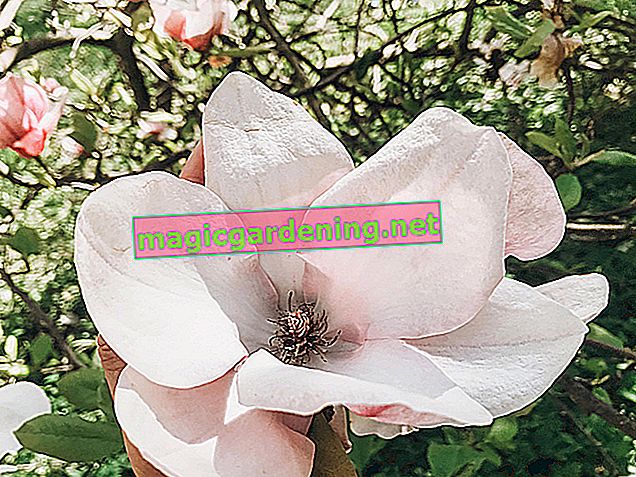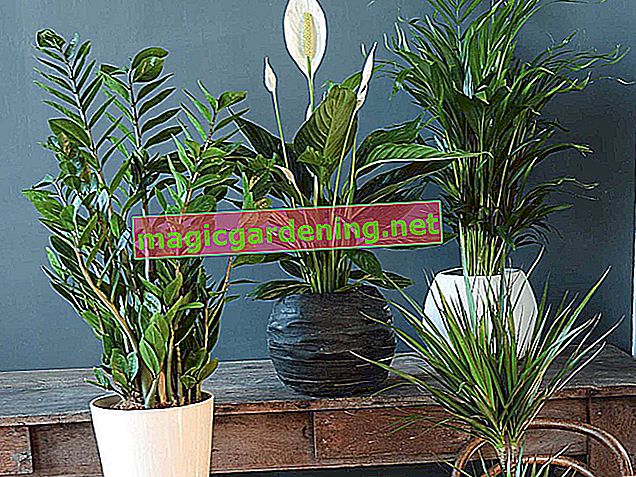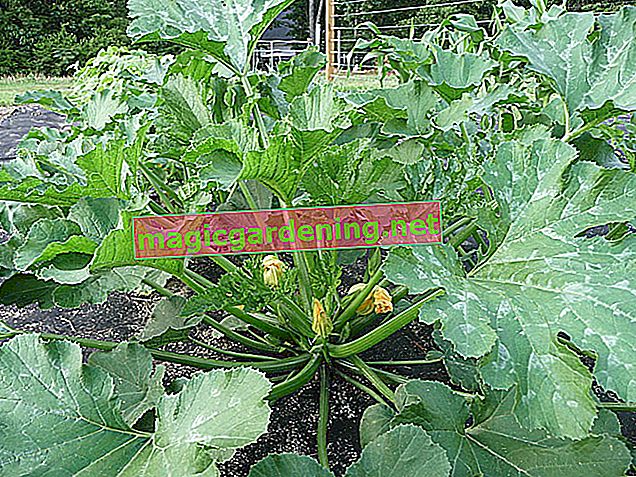
Plant balloon flower correctly
When the last frosts in the ground have cleared in spring, the time window for planting balloon flowers opens. In the sunny to partially shaded location, create the planting pits at a distance of 20-25 cm in the well-drained soil. The excavation is mixed with compost and horn shavings, (€ 6.39 at Amazon *) so that the Asian beauties lack for nothing. While preparing the soil, put the potted root balls in water until they are completely soaked. Only then do you pot the Chinese bellflower in order to set it in the ground while maintaining the previous planting depth. If you water abundantly and regularly on the day of planting and subsequently, the rooting will progress quickly.
also read
- Can you plant the balloon flower on the balcony?
- When and how long does the balloon flower bloom?
- Is the balloon flower poisonous?
Care tips
The care program is based on a balanced water and nutrient balance, directly dependent on the general conditions at the selected location. The sunnier the location, the more often it is watered. The leaner the soil, the richer the nutrient supply. These key points must be observed for a successful cultivation:
- Keep the perennial constantly moist
- From April to August fertilize the bed with compost and horn shavings
- Apply a liquid fertilizer to the pot every 14 days
- Clean up withered flowers as soon as possible
- Cut back close to the ground, either in autumn or in early spring
Regardless of their robust frost hardiness, permanent winter wetness can cause problems for the perennial. A protective layer of autumn leaves or coniferous twigs effectively prevents damage. In the pot, the balloon flower ideally moves to frost-free winter quarters. If there is not enough space, the vessel is covered with jute, fleece or foil. A block of wood or a styrofoam plate placed underneath protects the root ball from the cold rising from the ground.
Continue reading
Which location is suitable?
For a balloon flower in the garden, look out for a place with the following conditions:
- Sunny to partially shaded location
- Warm and sheltered from the wind
- Fresh to semi-dry soil, preferably sandy-clay
- Humorous, nutrient-rich and with a slight calcium content
In view of these wide-ranging requirements, the sun-drenched rock garden is just as possible as the protected wooded edge, the mixed herbaceous bed and, in the pot, the warm terrace and the south-facing balcony.
Continue reading
The correct planting distance
The balloon flower unfolds its distinctive effect wonderfully in small tuffs. This is especially true against the dark backdrop of deciduous trees or in the perennial bed in the vicinity of other summer beauties. With a planting distance of 20-25 cm, you are exactly right when it comes to creative design.
What soil does the plant need?
The demands of a balloon flower on the soil conditions can be met with a little care. The soil should be well permeable so that the deep taproot can gain a foothold unhindered. Fresh to moderately dry soil with a sandy-clay structure contributes to a long plant life. The perennial feels in good hands in a nutrient-rich, humus-rich soil that is slightly calcareous. For the pot substrate, this means that a structurally stable potted plant soil based on compost is a good choice, optimized with a little lava granulate (€ 10.95 at Amazon *) or sand.
What is the best time to plant?
Although you are holding a long-lasting perennial with a balloon flower, we still advise against the classic autumn planting. So that the Asian immigrant has enough time to root, spring planting from the end of April / beginning of May has proven its worth in practice.
When is the flowering time?
The central flowering time of a balloon flower extends from July to August. If you clean out withered flowers consistently, the enchanting flower flora will last until September. If you cut back the perennial promptly, it does not unnecessarily invest its energy in the growth of seed heads in favor of a long flowering period in the next year.
Continue reading
Cut the balloon flower correctly
During the flowering period, wilted bell flowers are cut off consistently to make room for a second flowering. When the flower festival draws to a close, the perennial begins to move in. It is your individual decision whether the flower should produce seed pods for self-sowing. Of course, this show of strength shortens the lifespan and vitality. The pruning can be done either immediately after flowering or in late winter. Since the Chinese bellflower is an excellent cut flower, cut the stems off at the base when they are budding.
Continue reading
Watering balloon flower
The water requirement of a Chinese bellflower is at a medium to high level. Water the perennial evenly and regularly, because drought stress has a negative effect on growth and willingness to flower. During hot and dry summer periods, this can be the case every day, both in the bed and in the tub. The morning thumb test provides information about the watering requirement. Always pour the water directly onto the root disc with the jug nozzle, as long as the sun's rays are not yet brushing the flowers and leaves.
Fertilize balloon flower properly
In order to produce the extravagant balloon buds and lavish bell flowers, the perennial uses a lot of force. A balanced supply of nutrients during the growing season ensures that the Asian beauty of flowers does not run out of breath prematurely. How to fertilize correctly:
- A nitrogen-emphasized start fertilization in April acts as an initial spark for this year's season
- Then fertilize the bed every 3-4 weeks with compost and horn shavings
- Supply balloon flowers in pots with a liquid fertilizer every 14 days from April to August
This year's fertilizer application ends by mid-August at the latest, so that the perennial ripens in time for winter.
Overwinter
Assigned to the winter hardiness zone Z4, the balloon flower can withstand temperatures down to - 28.4 degrees Celsius. It is not so much the freezing frost that afflicts it, but rather the fluctuations between frost and thaw and the resulting permanent wetness. As a precaution, experienced hobby gardeners therefore spread a layer of leaves and brushwood over the root disc. Cultivated in pots, the Chinese bellflower ideally moves to frost-free winter quarters. Alternatively, the planter can be given a winter coat made of fleece, jute or bubble wrap and a cold-insulating base made of wood.
Continue reading
Propagate balloon flower
Due to the elongated, beet-like taproot, the propagation of balloon flowers by means of division is not very promising. If you want more specimens, sowing proves to be practicable. Follow these steps:
- Spread the brown, egg-shaped seeds on peat sand or commercial seed compost
- Sieve a thick layer of sand over the seeds, press down and moisten with a fine showerhead
- Place in the greenhouse or under a transparent hood on the partially shaded windowsill
- At a constant 20 degrees Celsius, germination begins within 8-14 days
As soon as the seedlings have 2 pairs of leaves, they are pricked out. Start sowing at the end of February / beginning of March, hold strong young plants in your hands in May, ready to be planted in the bed. Please note that only F1 hybrids have the potential to reliably flower in the first year. Seedlings from normal seeds can sometimes take 1 to 2 years to bloom.
Continue reading
How do I transplant properly?
Do not expect your balloon flower to change location in the bed, because the Asian beauty reacts extremely annoyed. Since the perennial drives a deep tap root into the ground, any attempt at transplanting is unsuccessful. In contrast, repotting succeeds without any problems. As soon as the Chinese bellflower has completely rooted its pot, it makes sense to switch to a larger planter. The best time for this maintenance measure is early spring, shortly before the new budding.
Balloon flower in the pot
The balloon flower spreads its picturesque flair wonderfully in the pot on the summer balcony. In order for cultivation to proceed in a regulated way, you should not skimp when choosing a high-quality potting soil. Avoid peat-containing substrates in favor of structurally stable quality goods that are enriched with lava granulate, expanded clay (€ 17.50 at Amazon *) and other additives. A few pottery shards above the water drain prevent damaging waterlogging as drainage. With these optimal conditions, the maintenance program is limited to these points:
- Keep the substrate constantly moist without causing waterlogging
- Apply a liquid fertilizer for flowering plants every 14 days from May to August
- Regularly clean withered flowers
- Cut back close to the ground, either in autumn or late winter
If the pot has a diameter of less than 30 cm, move it to frost-free winter quarters as a precaution. This can be the garage or the unheated staircase or a similar room. Cover larger buckets with bubble wrap or jute tape and position them in front of the south wall of the house on a block of wood.
Is balloon flower poisonous?
The use of leaves, flowers and roots in Asian cuisine and folk medicine belies the health-threatening status. In fact, the balloon flower contains poisonous saponins and other questionable ingredients. The University of Georgetown wanted to know exactly and confirmed the toxicity. Although the healing powers of the perennial cannot be denied, hobby gardeners should refrain from cultivation within the reach of children and pets.
Continue reading
Nice varieties
- Fuji Pink: When the balloon-like buds unfold, the flower dresses in pale pink bell-shaped petals
- Mariesii: The variety captivates with magnificent bell flowers in an intensely bright blue
- Fuji White: Pure white blooming balloon flower, which contrasts wonderfully with blue blooming species and varieties
- Astra Blue: Premium variety with violet-blue flowers and robust longevity
- Mother-of-pearl bowl: Noble cultivation with mother-of-pearl shimmering bell flowers and expansive habit
- Hakone Blue: Splendid variety with double-layered petals in a deep blue
- Early Sentimental Blue: Valuable F1 hybrid with compact and small growth; ideal for pot culture
- Fariy Snow: The white bell flowers are criss-crossed with filigree, blue stripes; very stable breeding








